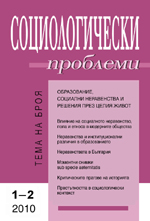Участие в неформално обучение в страните от ЕС-15 и ЕС-8: странични фактори на търсенето и предлагането
Participation in Non-formal Learning in EU-15 and EU-8 Countries: Demand and Supply Side Factors
Author(s): Ellu Saar, Eve-Liis RoosmaaSubject(s): Social Sciences
Published by: Институт по философия и социология при БАН
Summary/Abstract: The aim of the paper is to provide an in-depth analysis of participation in non-formal learning in different European Union member states with main comparison between EU-15 and new EU member states. Authors examine the training gap by distinguishing characteristics of the supply and demand for skills, assuming that employers demand for skills has an important impact on training incidence. Analysis is based on Eurostat Adult Education Survey (2007). Results indicate that comparative theoretical frameworks developed in relation to a few large, socio-economically advanced EU-15 countries cannot be fully applied across the enlarged Europe. Inequality in participation in non-formal education reflects more occupational distribution (job requirements) than the available qualifications of the workforce. Moreover, inequality in participation is higher in countries with higher percentage of low-skilled occupations, and thus with lower innovation performance. Yet in new EU member states also higher percentage of professionals and managers is increasing inequality in training participation. This might be due to the active role of the state in providing further training mainly to professionals. In the light of an enlarged EU the development of integrated EU policies needs to pay special attention to the conditions of associate countries, as transitions at the institutional level are lengthy.
Journal: Социологически проблеми
- Issue Year: 42/2010
- Issue No: 1-2
- Page Range: 175-200
- Page Count: 26
- Language: Bulgarian
- Content File-PDF

